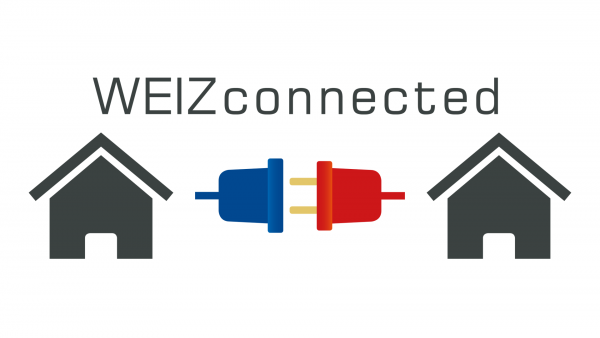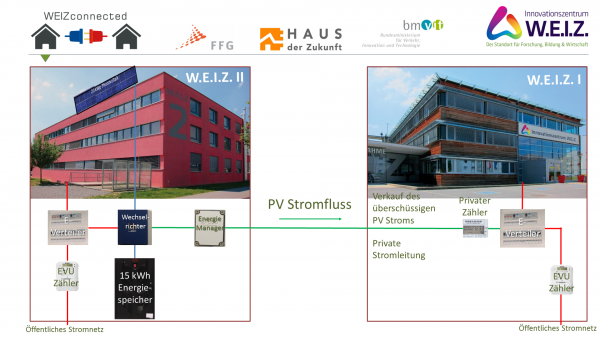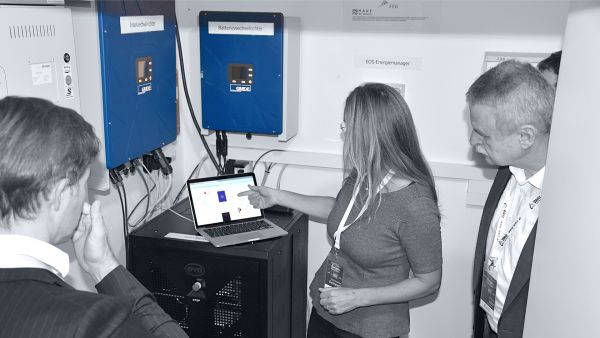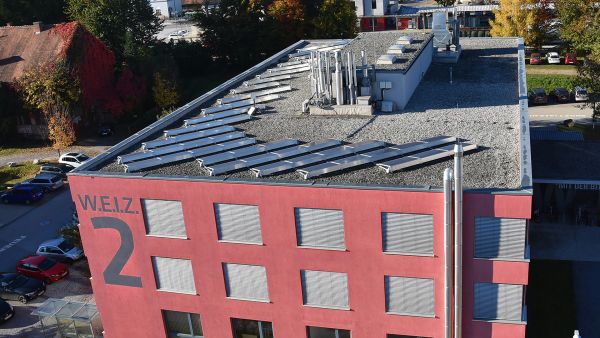WEIZconnected - crossbuilding energy exchange
Short Description
Starting point/Motivation
A building integrated energy supply, which is based on renewable and decentralised energy sources, in combination with an intelligent energy-management system, enables an optimized (part) autarky by merging complementary load profiles. In this way the power feed into the grid can be reduced, losses can be minimized and the economic use of renewable sources can be supported. The combination of the subfields, intelligent energy production, systematic energy exchange across buildings and consumption, energy storage, as well as centralized management under the given circumstances are the starting points of this project.
The integration of a system that enables energy exchange across buildings in superior grids is challenging. Especially the interfaces between the individual systems pose difficulties. In that case, the technological as well as the economic aspects are important to be considered. Such systems, which allow an intelligent energy exchange across buildings incl. decentralized generating and storing enable,
- the management of the excess production without using the grid infrastructure, on distribution as well as on transmission grid level,
- a significant reduction of feed-in peeks,
- a reduction of grid-consumption peeks,
- an optimized development of future advantages of Smart Grids,
- an economic use of renewable energy sources
- and the provisioning of a broad spectrum of grid related services.
Contents and Objectives
The objectives of the project WEIZconnected are the conception, the development and the trial operation of an entire system for the energy exchange across buildings. The aim of the system is the maximization of the autarky by using supplementary load profiles. Moreover, a major goal was the development and the verification of two technical pilot sites.
As fist steps the focus of the project has been on the clarification of the legal and economic aspects, on finding appropriate ways of problem solving by the development and adaption of single components as well as on the integration of them in the overall system. A further focus has been on intelligent controlling and monitoring systems and moreover on the building-integrated sustainable energy supply. Thus, the focus has been on the following areas:
- Electricity generation with building-integrated photovoltaic plants (a high level of utilization of the generated electricity in the respective building complex is aspired)
- Energy storage (usage of battery storage systems)
- Development and use of an intelligent energy management and monitoring system
- Development of interfaces for the connection with the electricity grid
Methods
As first step for the formulation of the technical approach and for the realization of the pilot plants, the project specific framework conditions and the requirements, which are necessary for an electricity exchange across buildings, had to be clarified. Therefore, the planed pilot projects have been discussed and analysed in detail and the technical and economical requirements have been developed together with the owners of the properties.
In this context, a detailed analysis of the legal framework considering of the ownership structures has been done. Therefore, a lot of iteration loops had to be done to determine the final test sites. After making this decision, detailed concepts have been worked out. These concepts served as a basis for the development and the programming of the necessary components of the overall system. After finishing the planning and development work, the installation and commissioning of the two pilot projects have been carried out. Moreover, an own monitoring system has been developed and installed to enable the recording of the relevant data. With the help of this system the performance of the pilot plants has been continually monitored and analysed and the system parameters have been optimised. In addition to that, an investigation has been carried out by the grid operator during the demo mode to investigate the influence of the system on the voltage quality of the grid. Furthermore, the gained knowledge has been used for an economic efficiency calculation of the test sites. Finally, conclusions and recommendations for actions have been derived after detailed analysis of all results.
Results
The solution developed within the project WEIZconnected shows, that an electricity exchange across buildings of renewable energy is technically and legally possible according to the legal situation valid during the project period. Because of the developed legal requirements, it turned out, that the electricity supply across buildings is (currently) only reasonable with a direct line. According to the legal matters the following statements can be made:
- A direct line from A (provider/producer) to B (consumer) is legally possible. However, A is not allowed to supply B with energy from the public grid, but only with energy produced by the decentralized energy system.
- A direct line is only permitted if the electric circuits are separated, because otherwise the self-produced electricity of the PV-plant is "mixed" with the public electricity. However, the technical implementation is not clarified in the law.
- In case of the supply via the public grid (without a direct line), both (A & B) must be part of a balance group. The provider A must take responsibility for the balance group (complex calculation).
The grid operator (Energie Steiermark AG) stated the following technical requirements for the implementation of a direct cable: (1) On the connecting line grid power must never flow from the utility. (2) Only self-produced PV power may flow via the direct line. (3) At no time (not even during switching operations of the connection device) may network disturbances occur.
The developed energy management and monitoring system is able to ensure compliance with the general conditions by means of the established measurement and control strategy, by using two switches with a time delay. The inclusion of a battery storage system enables on the one hand the increase of the photovoltaic self-consumption rate at the demonstration sites and on the other hand the battery storage ensures that short-time power drops do not immediately lead to a switch of the direct line.
The verification of the functionality of the developed components and of the economic operation of the entire system for the electricity exchange across buildings could successfully be demonstrated by the pilot plants.
Prospects / Suggestions for future research
The framework conditions considered, refer to the legal situation prior to the amendment of the ElWOG in 2017, which is why a further evaluation of the legal situation has to be carried out for further development of the system. In addition, for the reproducibility of the results, the legal and economic overhead in the case of different ownership relationships must be examined.
For the further development of the components and for the continuation of the technological approach, solutions for the star-shaped connection of several consumers to one single generation unit are also to be considered.
Project Images
Terms of use: The pictures listed underneath the header “Project Pictures” originate from the projects in the frame of the programmes City of Tomorrow, Building of Tomorrow and the IEA Research Cooperation. They may be used credited for non-commercial purposes under the Creative Commons License Attribution-NonCommercial (CC BY-NC).
Project Partners
Project management
DI Franz Kern - W.E.I.Z. Immobilien GmbH
Project or cooperation partners
Contact Address
W.E.I.Z. Immobilien GmbH
DI Franz Kern
Franz-Pichler-Straße 30
A-8160 Weiz
Tel.: +43 (3172) 603-1101
E-Mail: franz.kern@w-e-i-z.com
Tel.: +43 (3172) 603-0
Fax: +43 (3172) 603-9
E-Mail: campus@w-e-i-z.com
Web: www.w-e-i-z.com




